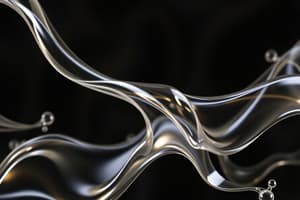Podcast
Questions and Answers
What describes a solid in terms of volume and shape?
What describes a solid in terms of volume and shape?
- Has a definite shape but variable volume
- Has a definite volume but no definite shape
- Has neither definite volume nor shape
- Has a definite volume and shape (correct)
What is the primary characteristic of a gas?
What is the primary characteristic of a gas?
- Has both definite volume and shape
- Has a definite volume but no definite shape
- Has neither definite volume nor definite shape (correct)
- Has a fixed volume and variable shape
Under what conditions do solids such as plastics typically change to liquids?
Under what conditions do solids such as plastics typically change to liquids?
- High pressure only
- High temperature only
- After solidification from a gas
- Special temperature and pressure conditions (correct)
What term describes the tiny particles that make up solids, liquids, and gases?
What term describes the tiny particles that make up solids, liquids, and gases?
How is density defined in the context of physical states of matter?
How is density defined in the context of physical states of matter?
What principle explains why objects float or sink in a fluid?
What principle explains why objects float or sink in a fluid?
Which of the following states of matter has no definite volume?
Which of the following states of matter has no definite volume?
What is a common feature of liquids in contrast to solids?
What is a common feature of liquids in contrast to solids?
Which type of thermometer provides very accurate temperature measurements?
Which type of thermometer provides very accurate temperature measurements?
What is the freezing point of mercury in Celsius?
What is the freezing point of mercury in Celsius?
Which temperature corresponds to water boiling on the Fahrenheit scale?
Which temperature corresponds to water boiling on the Fahrenheit scale?
What is the formula used to convert temperature from Fahrenheit to Celsius?
What is the formula used to convert temperature from Fahrenheit to Celsius?
Which property of matter is NOT mentioned as changing with temperature?
Which property of matter is NOT mentioned as changing with temperature?
At what temperature does ice melt on the Celsius scale?
At what temperature does ice melt on the Celsius scale?
What is the maximum temperature Mercury can reach before boiling?
What is the maximum temperature Mercury can reach before boiling?
Which of the following is the absolute temperature scale?
Which of the following is the absolute temperature scale?
What occurs at the yield point of an elastic material?
What occurs at the yield point of an elastic material?
Which of the following best describes Hooke's Law?
Which of the following best describes Hooke's Law?
What formula represents the relationship as per Hooke’s Law?
What formula represents the relationship as per Hooke’s Law?
What is stress defined as?
What is stress defined as?
If a material stretches beyond its elastic limit, it will:
If a material stretches beyond its elastic limit, it will:
Strain is defined mathematically as:
Strain is defined mathematically as:
At the breaking point, a material experiences:
At the breaking point, a material experiences:
What is the elastic region in a stress-strain diagram?
What is the elastic region in a stress-strain diagram?
What is the relationship between temperature and the size of solids in thermal expansion?
What is the relationship between temperature and the size of solids in thermal expansion?
Which formula represents the mathematical expression for linear expansivity?
Which formula represents the mathematical expression for linear expansivity?
In the formula 𝑙2 = 𝑙1 (1+∝ ΔT), what does 𝑙2 represent?
In the formula 𝑙2 = 𝑙1 (1+∝ ΔT), what does 𝑙2 represent?
What role does thermal expansion play in construction?
What role does thermal expansion play in construction?
If a solid's length increases by 5 cm when the temperature rises by 10℃, what does this indicate?
If a solid's length increases by 5 cm when the temperature rises by 10℃, what does this indicate?
What is represented by the symbol alpha (∝) in the context of thermal expansion?
What is represented by the symbol alpha (∝) in the context of thermal expansion?
What happens to the intermolecular forces in a solid when it is heated?
What happens to the intermolecular forces in a solid when it is heated?
Which of the following is NOT a factor that affects thermal expansion?
Which of the following is NOT a factor that affects thermal expansion?
What is the relative density (R.D) of a substance defined as?
What is the relative density (R.D) of a substance defined as?
What is the relative density of water?
What is the relative density of water?
What type of stress can a fluid exert on an object submerged in it?
What type of stress can a fluid exert on an object submerged in it?
How is pressure (P) defined mathematically in the context of fluids?
How is pressure (P) defined mathematically in the context of fluids?
What unit is used to measure pressure?
What unit is used to measure pressure?
Which factors does pressure depend on in a liquid?
Which factors does pressure depend on in a liquid?
If a liquid has a density of 1000 kg/m³ and the height of the liquid is 2 m, what is the pressure at the base of the container?
If a liquid has a density of 1000 kg/m³ and the height of the liquid is 2 m, what is the pressure at the base of the container?
How does the shape of the container affect the pressure at the base of the liquid?
How does the shape of the container affect the pressure at the base of the liquid?
Flashcards are hidden until you start studying
Study Notes
Properties of Matter
- Matter is anything that has weight and occupies space.
- Matter can exist in three states: solids, liquids, or gases.
- Solids have a definite volume and shape.
- Liquids have a definite volume but not a definite shape.
- Gases have neither a definite volume nor shape.
Elasticity
- Elasticity is the ability of a material to return to its original shape and size after a force is removed.
- The elastic limit is the point beyond which a material will not return to its original shape.
- The yield point is the point beyond the elastic limit where a material begins to permanently deform.
- The breaking point is the maximum extension or compression a material can withstand before breaking.
- Hooke's law states that the extension of an elastic material is directly proportional to the applied force, provided the elastic limit is not exceeded.
Hydrostatics
- Density is the mass per unit volume of a substance.
- Specific gravity or relative density is the ratio of the density of a substance to the density of water.
- Pressure is the force per unit area.
- Pressure in a liquid depends on the density of the liquid and the depth.
Temperature and Heat
- Temperature is a measure of the average kinetic energy of the molecules in a substance.
- Thermal expansion is the change in size of a material due to a change in temperature.
- Linear expansion is the change in length of a material due to a change in temperature.
- Linear expansivity is the increase in length per unit length per degree Celsius (or Kelvin).
Heat Transfer
- Heat transfer is the process of energy transfer from one object to another due to a temperature difference.
- Conduction is the transfer of heat through a material by direct molecular contact.
- Convection is the transfer of heat by the movement of fluids (liquids or gases).
- Radiation is the transfer of heat through electromagnetic waves.
Laws of Thermodynamics
- The laws of thermodynamics describe the relationships between heat, work, and internal energy.
- The first law of thermodynamics states that energy cannot be created or destroyed, only transferred or transformed.
- The second law of thermodynamics states that the entropy of a closed system always increases.
- The third law of thermodynamics states that the entropy of a system approaches a constant value as the temperature approaches absolute zero.
Kinetic Molecular Theory of Gases
- The kinetic molecular theory explains the behavior of gases in terms of the motion of their molecules.
- Gas molecules are in constant random motion
- Gas molecules have negligible volume compared to the space they occupy
- Collisions between gas molecules are perfectly elastic
- The average kinetic energy of gas molecules is proportional to the absolute temperature.
Solved Problems
- A steel rod increases its length by 5 cm when the temperature increases by 10°C.
- To calculate the linear expansivity of the steel rod, you would need to know the original length of the rod.
Studying That Suits You
Use AI to generate personalized quizzes and flashcards to suit your learning preferences.





